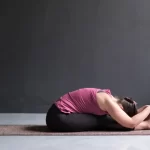Nadia Shodhana’s, also known as alternate nostril breathing, is a pranayama (breathing) technique used in yoga and meditation to help calm and relax the mind and body. This technique involves inhaling through one nostril while blocking the other nostril with your finger, then exhaling through the opposite nostril while blocking the first nostril with your finger. This process is then repeated, alternating nostrils for each inhale and exhale.
Shodhana is Sanskrit for “purification,” while nada means “channel or flow” in the language. Therefore, the main goal of Nadi Shoshana is to balance the system as a whole while cleansing and purifying the subtle pathways of the mind-body organism. It balances the three doshas and is a good exercise for almost everyone.
By practicing Nadi Shodhana, you may experience a number of benefits, including:
- Calming the mind: This breathing technique is believed to help reduce stress and anxiety by slowing down the breath and promoting relaxation.
- Balancing the nervous system: Nadi Shodhanas is said to help balance the sympathetic and parasympathetic nervous systems, which can help regulate the body’s response to stress.
- Improving focus and concentration: By calming the mind and reducing stress, this breathing technique may help improve focus and concentration.
- Enhancing respiratory function: Alternate nostril breathing can help improve the flow of air through the nostrils, which can improve respiratory function and reduce the risk of respiratory conditions.
Overall, practicing Nadi Shodhana can be a helpful tool for anyone looking to calm their mind and body, reduce stress and anxiety, and promote relaxation and well-being.
One of the key benefits of Nadi Shodhana is its ability to balance the flow of prana (life force energy) throughout the body. In traditional yogic philosophy, it is believed that prana flows through the body in channels called Nadia Shodhana By practicing Nadi Shodhana, you can balance the flow of prana through the Ida and Pingala Nadia Shodhana which are said to run along the left and right sides of the spine, respectively.
In addition to its benefits for the mind and body, Nadi Shodhana is also thought to have spiritual benefits. By balancing the flow of prana, it is believed that the technique can help awaken the Kundalini energy, which is said to lie dormant at the base of the spine. As this energy is awakened, it can rise up through the chakras (energy centers) of the body, leading to greater spiritual awareness and enlightenment.
To practice Nadi Shodhana, find a comfortable seated position with your spine straight and your hands resting on your knees. Close your eyes and take a few deep breaths to center yourself. Then, using your right hand, block your right nostril with your thumb and inhale through your left nostril.
At the top of your inhale, release your thumb and use your ring finger to block your left nostril as you exhale through your right nostril. Then, inhale through your right nostril, release your ring finger, and exhale through your left nostril while blocking your right nostril with your thumb. This completes one round of Nadi Shodhana. Repeat for several rounds, alternating nostrils for each inhale and exhale.
As you practice Nadi Shodhana, focus on breathing slowly and deeply, and try to keep your mind focused on your breath. With regular practice, you may begin to notice a greater sense of calm, relaxation, and balance in both your mind and body.
In addition to benefits for relaxation and stress relief, Nadi Shodhana breathing has also been studied for its potential therapeutic benefits. For example, research suggests that this breathing technique may help lower blood pressure, reduce symptoms of anxiety and depression, and improve respiratory function.
In Sanskrit, the words “Nadi Shodhana” and “Purify” both mean “flow” or “channel,” respectively. When breathing is done constantly for a while in alternate nostrils, the purifying process of Nadi occurs.
“Nadi Shuddhi” refers to the process of purifying the Nadis in order to activate the primary energy channel Sushumna. Nadi Shodhana Pranayama is the name of the pranayama technique we employ for the “Nadi Shuddhi” process.
Purpose of Nadi Shodhana Pranayama
According to yogic science, our body’s energy moves through Nadis or subtle bodily pathways. Nadis become blocked as a result of several physical and psychological conditions, such as injury, stress, anxiety, fear, etc., which affects how well the body and mind work.
There are three important Nadis Ida, Pingala, and Sushumna through which Prana energy spread into the 72,000 Nadis to flow into the whole body.
The purpose of Nadi Shodhana Pranayama is to clear all 72,000 Nadis so that there isn’t any obstruction in the flow of Prana. Hatha Yoga said after Asana practice when there is a surge of energy in the body, the role of Nadi Shodhana comes to purify Nadis before that energy spread throughout the whole body. Moreover, when the consistent practice of Nadi Shodhana activates and harmonizes Ida and Pingala Nadi, it leads to the opening of closed Sushumna Nadi. Further, the opening of Sushumna Nadi gives rise to the awakening of the kundalini.
Effect of Nadi Shuddhi on Ida, Pingala, and Sushumna

The center energy channel, Sushumna Nadi, is opened when the Ida and Pingala Nadis, which run on either side of the spinal column, are in balance.
Ida Nadi represents the tamas guna, moon, coolness, or the feminine aspects that are associated with the left nostril. Whereas, the Pingala Nadi represents the raja’s guna, heat, sun, and masculine space of the individual concerning the right nostril.
When an individual practices the Nadi Shodhana Pranayama, it results in balancing the Ida and Pingala Nadi or Left and Right brain hemispheres or Feminine and Masculine aspects. This results in the activation of the Sushumna Nadi the centermost Nadi runs through all of the seven chakras residing on the spine.
It also expands access to the vast array of health and wellness options that might help someone find their spiritual path. the highest way to live. In addition, it guarantees the respiratory system’s functionality and effectiveness to support continued Nadi Shodhana pranayama exercise.

Preparation for Nadi Shodhana Pranayama
It is advised to be familiar with the fundamentals of practice before beginning the actual Nadi Shodhana, especially for those who are new to pranayama.
Nadi Shodhana Pranayama Mudra
In Nadi Shodhana Pranayama, a person can use
Nadi Shodhan Pranayama
and Nasagra Mudra to close the nostrils in an easy manner and effective. Both mudras are always made using the right hand only.
Curl the middle and index fingers of your right hand inward to form the Vishnu mudra. Right now, the right nostril is closed with the thumb, and the left nostril is closed with the ring finger. The thumb and ring fingers are squeezed together to seal the nostrils to help you hold your breath.
When practicing, those who find it uncomfortable to bend their fingers can use the Nasagra mudra.
The index and middle fingers are inserted between the two eyebrows at the base of the nose in the Nasagra mudra. The Vishnu mudra is comparable to how the nostrils are used. Although both mudras function equally, Nasagra mudra makes it simpler to focus during Nadi Shodhana.
Inhale-exhale same nostril

Always begin with this easy breathing before performing Nadi Shodhan Pranayama to thoroughly open both nostrils. Uninostril breathing occurs when breathing is done through a single nostril.
- Lie down in Siddhasana. With your right thumb, cover your right nostril, take a deep breath in through your left nostril, and then exhale fully through the same nostril. Run it ten times.
- Then use your right ring finger to seal the left nostril. Ten times, inhale and exhale through the right nostril in the same way.
Start with a breathing ratio of 1:1 throughout this preparation, then work your way up to 1:2.
Inhale-exhale opposite nostril at one time
Work on inhaling through one nostril and exhaling the other to balance the breathing cycle.
- As in the stage before, sit. With your right thumb, cover your right nose, then inhale deeply through your left nostril. Exhale completely after sealing the left nostril with the right ring finger. One cycle, then.
- Inhale left and exhale right ten times in a row to complete the cycle. Chandra Bhedana Pranayama is the name of it.
- After the 10th round, reverse your breathing pattern i.e. firstly inhale through the right nostril while the left nostril close. And then exhale through the left nostril while the right nostril is closed. It’s called Surya Bhedana Pranayama.
When Chandra and Surya Bhedana are performed together in a single cycle, Nadi Shodhana Pranayama without breath retention results.
How to Do Nadi Shodhana Pranayama?
- Start by settling into a comfortable cross-legged position, such as Siddhasana (the accomplished pose), Sukhasana (the easy pose), or Padmasana (Lotus Pose).
- Here, relax and take a few gentle breaths while straightening your spine, neck, and shoulders. The left kneecap is covered by the left hand.
- Use your right hand to perform either the Vishnu mudra or the Nasagra mudra.
- At shoulder height, raise your right arm. Bend the right elbow such that the hand comes straight in front of the nose without dipping down.
- Start the first cycle of Nadi Shodhana pranayama by using your thumb to cover your right nostril. Put your thumb right underneath your nose’s bony portion.
- Expanding your chest, inhale deeply and slowly from the left nostril.
- With your ring finger, seal the open left nostril after inhaling. For a little while, keep your breath inside your body.
- Release the thumb from the right nostril and slowly exhale while your chest and abdomen contract.
- Next, take a deep breath in through the same right nostril, hold it there, and then exhale out of the left nostril. The first round of Nadi Shodhana Pranayama is over.
- The procedure should be repeated. 20 times should be done at once.
Breathing Ratio
In Nadi Shodhana Pranayama, the ratio of inhalation to breath retention to exhalation is 1:4:2.
According to the Gheranda Samhita, a classic on hatha yoga, yogis should start their practice with 12 counts of inhaling, 48 counts of retention, and 24 counts of exhaling. Breath counts can be raised up to 20 inhalations, 80 retentions, and 40 exhalations with practice and gradual growth.
However, it is recommended to start with a ratio of 1:1:1 for novices who are doing Nadi Shodhana without any guru’s direction and to increase this ratio to 1:2:2 after a month of constant practice. Then gradually increase your stamina until you reach the standard ratio of 1:4:2.
Moreover, In further higher stages, external breath retention (kumbhaka) is added to Nadi Shodhana. It makes the breathing ratio look like this 1:4:2:2.
Contraindications of Nadi Shodhana Pranayama
- When you have a cold or runny nose, avoid performing Nadi Shodhana pranayama. This might obstruct breathing or cause a windpipe obstruction.
- Practitioners who are prone to dust particles or are allergic should avoid practicing this pranayama around dirt places. An open space with clear air or an indoor airy room could be the better option in this regard.
- Nadi Shodhana pranayama should not be performed by sinus patients if they are experiencing nose or throat pain or inflammation. In such discomfort, the procedure would unlikely produce the desired results.
Precautions
- Practitioners with high blood pressure and asthma should avoid breath retention because it could be dangerous if ignored.
- You are pushing your breath beyond its natural limitations if you experience shortness of breath during Nadi Shodhana. If you start to feel queasy, lightheaded, or dizzy, stop the practice right away.
- Nadi Shodhana pranayama should not be performed by anyone who has a mouth, nose, throat, or lung infection of any kind. Otherwise, a dangerous situation might arise.
- It is not recommended to perform this pranayama immediately after eating, but rather to wait for at least 3 to 4 hours.
Beginners Tips
- When performing Nadi Shodhana Pranayama, beginners should refrain from applying pressure to any one side of the nose. The delicate tissue and cartilage of the nose could be harmed by this.
- Instead of rushing through their breaths, new practitioners should concentrate on taking deep breaths slowly. In the end, this wouldn’t produce the right outcomes.
- Beginners should maintain a straight spine to allow adequate space for the diaphragm to contract and relax as well as for the lungs. This will intensify the body’s response to breathing.

Nadi Shodhana’s Pranayama Benefits
The benefits of Nadi Shodhana Pranayama for the body and mind are numerous. It puts the brain in a healthy state so that it can become attentive to the present. Here are several advantages;
1. Synchronize Brain Hemisphere
By balancing the Ida and Pingala Nadis, which are associated with the opposing hemispheres of the brain, Nadi Shodhana pranayama can aid. The right hemisphere or parasympathetic nervous system is activated upon inhalation through the left nostril (relaxation reaction). The left hemisphere, or sympathetic nervous system, is activated upon right-sided inhalation and is responsible for the fight-or-flight reaction.
Nadi Shodhana guarantees that both brain hemispheres operate at their peak potential and in harmony with one another.
2. Improves Blood circulation
This pranayama’s deep breathing enhances blood circulation throughout the body, allowing the muscles, lungs, heart, and other organs to work to their full potential. As a result, it boosts immunity and prevents illnesses.
3. Develops Pulmonary Health, Keeps Lungs Healthy
Every component of the pulmonary system, including the nose, throat, larynx, trachea, bronchi, and lungs, can work together in harmony while breathing deeply and slowly. Due to the increased breathing capacity and volumes (expiratory flow), this leads to a productive output [efn note]. The instantaneous impact of “Nadi-Shodhana pranayama” on a few chosen parameters of the heart, lungs, and higher brain functions.https://www.ijhsr.org/IJHSR_Vol.9_Issue.10_Oct2019/7.pdf [/efn_note]
4. Promotes upliftment of Prana
The ultimate aim of the Nadi Shodhana Pranayama is to clear the pathway or Subtle energy channels for the Prana to flow freely. Breathing in this pranayama practice is so intense that it stimulates the Prana so efficiently, that balances the Ida and Pingala Nadis. This further stimulates Sushumna Nadi through which the spiritual energy is lifted up.
5. Helpful in Cardiovascular Health
According to one of the studies [efn_note] On Spectral Analysis of Heart Rate Variability during Very Slow Yogic Breathing https://ieeexplore.ieee.org/document/1616968?reload=true [/efn_note], it has shown that Slow breathing like Nadi Shodhana Pranayama helps in significantly lowering the heart rate. This maintains the rhythmic pattern of the heart, which ensures healthy heart functioning.
6. Activates Sahasrara Chakra
The Sushumna Nadi, which runs from the base of the spine (Mooladhara Chakra) to the top of the head, awakens when Ida Nadi and Pingala Nadi are in harmony (Sahasrara Chakra). The central Nadi is quickly filled with prana as it is cleared by Nadi Shodhana pranayama. As a result, it activates Sahashrara at the crown chakra after passing through all six chakras. It bestows the practitioner with a spiritual consciousness, the ability to let go of emotional obstacles, and mental tranquility.
Nadi Shodhan Pranayama Vs Anulom Vilom Pranayama
What distinguishes Anuloma Viloma Pranayama from Nadi Shodhana Pranayama?
There are a few differences between the two types of breathing exercises. People frequently mix things up and confuse them as a result. But there is a definite distinction between them.
Breath retention occurs during Nadi Shodan Pranayama. The Anulom Vilom Pranayama, however, does not involve breath-holding. Both exercises involve alternate nostril breathing, though. Anulom Vilom is a beginner-friendly technique, whereas Nadi Shodhan Pranayam is more advanced.
Conclusion
Alternate breathing, also known as Nadi Shodhana Pranayama, is a powerful technique for cleansing the subtle channels known as Nadis where the life force, or Prana, flows unhindered and freely.
This supports a person’s numerous characteristics, including their mental, bodily, and spiritual aspects. In order to balance the Sushumna and further activate the Sahasrara chakra, it also balances the Ida and Pingala. The spiritual lives of the practitioners are improved as a result.






















